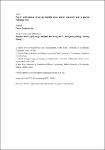Power performance of an asymmetric wave energy converter near a partial reflection wall
| dc.contributor.author | Zhou, B | |
| dc.contributor.author | Zhang, Q | |
| dc.contributor.author | Hu, J | |
| dc.contributor.author | Jin, P | |
| dc.contributor.author | Zhang, H | |
| dc.contributor.author | Zheng, Siming | |
| dc.date.accessioned | 2023-05-04T14:58:22Z | |
| dc.date.available | 2023-05-04T14:58:22Z | |
| dc.date.issued | 2023-07-15 | |
| dc.identifier.issn | 0029-8018 | |
| dc.identifier.other | 114634 | |
| dc.identifier.uri | https://pearl.plymouth.ac.uk/handle/10026.1/20796 | |
| dc.description.abstract |
Wave power absorption of a heaving-body wave energy converter (HBWEC) can be improved by making the device highly asymmetric and deploying it near a coastal wall, harbour pier, or breakwater. However, the coupling between the geometric asymmetry of the HBWEC and the partial reflecting boundaries of the various walls and the consequential influence on the power performance of the HBWEC are unclear. This research aims to fill this gap. A semi-analytical model based on the linear potential flow theory is proposed to deal with an HBWEC with an arbitrary bottom shape and a partial reflection wall. The degree of asymmetry (DoA) of the HBWEC and the reflection rate of the wall are mathematically defined. Results show that the wall increases the power performance of an HBWEC by increasing the reflected wave energy through an increase in the reflection rate. Practically, an HBWEC should have a larger DoA to make it more immune to the change of the reflection rate and therefore more adaptable to different situations. These findings could offer recommendations for the design and deployment of an HBWEC according to the properties of the wall, improving wave power absorption efficiency and avoiding unnecessary costs due to improper design. | |
| dc.format.extent | 114634-114634 | |
| dc.language | en | |
| dc.publisher | Elsevier BV | |
| dc.subject | 7 Affordable and Clean Energy | |
| dc.title | Power performance of an asymmetric wave energy converter near a partial reflection wall | |
| dc.type | journal-article | |
| dc.type | Journal Article | |
| plymouth.volume | 280 | |
| plymouth.publication-status | Published | |
| plymouth.journal | Ocean Engineering | |
| dc.identifier.doi | 10.1016/j.oceaneng.2023.114634 | |
| plymouth.organisational-group | |Plymouth | |
| plymouth.organisational-group | |Plymouth|Faculty of Science and Engineering | |
| plymouth.organisational-group | |Plymouth|Faculty of Science and Engineering|School of Engineering, Computing and Mathematics | |
| plymouth.organisational-group | |Plymouth|REF 2021 Researchers by UoA | |
| plymouth.organisational-group | |Plymouth|Users by role | |
| plymouth.organisational-group | |Plymouth|Users by role|Academics | |
| plymouth.organisational-group | |Plymouth|REF 2021 Researchers by UoA|UoA12 Engineering | |
| dcterms.dateAccepted | 2023-04-17 | |
| dc.date.updated | 2023-05-04T14:58:04Z | |
| dc.rights.embargodate | 2024-4-22 | |
| dc.rights.embargoperiod | forever | |
| rioxxterms.versionofrecord | 10.1016/j.oceaneng.2023.114634 |


